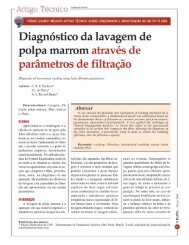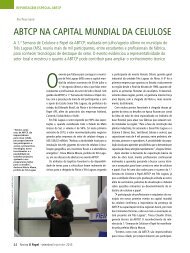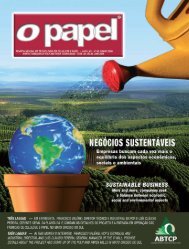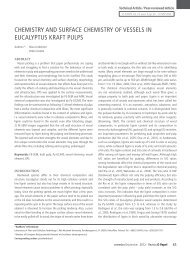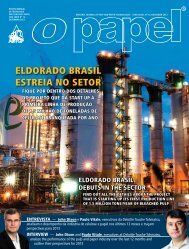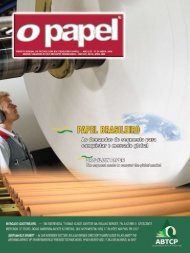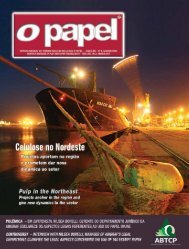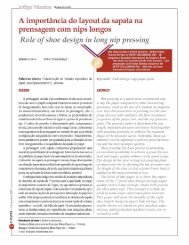You also want an ePaper? Increase the reach of your titles
YUMPU automatically turns print PDFs into web optimized ePapers that Google loves.
The role of xylan on gain and stability of brightnessof eucalyptus bleached pulp in relation to the finalbleaching stage / O PAPEL DA XILANA NO GANHO DE BRANCURAE NA SUA ESTABILIDADE EM RELAÇÃO AO ESTÁGIO FINAL DEBRANQUEAMENTO DE PASTA DE EUCALIPTOEvaluation/Avaliação: 10,00Authors/Autores: M. Graça V.S. Carvalho 1 ,Pedro E.G. Loureiro 2Dmitry V. Evtuguin 3Author´s references/Referências dos autores:1. CIEPQPF, Department of Chemical Engineering, Faculty ofSciences and Technology, University of Coimbra, Portugal2. Present address: Novozymes A/S Brudelysvej 32 DK-2880Bagsværd, Denmark3. CICECO, Dep. of Chemistry, University of Aveiro, PortugalABSTRACT/RESUMOBrightness stability is a key quality parameter of high brightnessbleached pulps. The impact of the final bleaching stage is assessed inthis study for the purpose of understanding the fundamental reasonsbehind the improved brightness stability of bleached eucalypt pulp whenthe conventional chlorine dioxide stage (D) is replaced by an alkalinehydrogen peroxide stage (P). Particular emphasis was devoted to therole of xylan, because within the fibrous structure this component hashigher accessibility to brightening agents. Xylan-depleted pulps andisolated xylans from partially (DED) and fully (DEDD/DEDP) bleachedeucalypt kraft pulps were characterized using UV-vis Diffuse Reflectanceand UV-Resonance Raman spectroscopy @ 325 nm. Isolate xylans weresubjected to treatment either with chlorine dioxide or alkaline hydrogenperoxide under the same final bleaching conditions as the DEDD/DEDPpulps and further characterized. In this study the role of xylan as a sourceof chromogen and chomophore structures in fully bleached pulps isshown. Final bleaching with chlorine dioxide induced new unsaturatedmoieties in xylan structure, absorbing at 240-260 nm, different from HexAresidues and from those present in the original xylan isolated from a DEDbleached pulp. Compared to chlorine dioxide, the final alkaline hydrogenperoxide stage is more efficient in terms of the removal of xylan-relatedchromophores, though it is more detrimental regarding the xylan integrity.The content of partially oxidized structures was significantly higher in theDEDD than in the DEDP bleached pulp, thus pre-determining the worstbrightness stability of the former. Under the alkaline conditions of thefinal peroxide bleaching stage the major part of degraded oxidizedcompounds are leached from the pulp, thus diminishing their contributionto the formation of chromophores during subsequent ageing. Conversely,the role of xylan into the delay of brightness development in the finalchlorine dioxide stage was also highlighted.Recyclability of commercial office papers: responseto two recycles / RECICLABILIDADE DE PAPÉIS DE ESCRITÓRIOCOMERCIAIS: RESPOSTA A DUAS RECICLAGENSEvaluation/Avaliação: 9,5Authors/Autores: Benitez, J.B. 1Otero de Almeida, M.L. 2Felissia, F.E. 3Park, S.W. 4Koga, M.E.T. 2Area, M.C. 3,5Author´s references/Referências dos autores:1. Maestría en Ciencias de Madera, Celulosa y<strong>Papel</strong> – FCEQyN-FCF – Universidad Nacional de Misiones2. Instituto de Pesquisas Tecnologicas de São Paulo (IPT)3. Programa de Celulosa y <strong>Papel</strong> - FCEQyN – UniversidadNacional de Misiones4. Escola Politecnica, Universidade de São Paulo (USP)5. Consejo Nacional de Investigaciones Científicas y Técnicas (CONICET)ABSTRACT/RESUMORecyclability is the ability of a material to reacquire the sameproperties it had originally. Knowledge of the recyclability ofcommercial paper is a tool for companies, when making decisionson expansions or process modifications. The aim of this work wasto verify the recyclability of four printing and writing papers, fromtheir physical, mechanical and optical properties after two recycles.Four bond commercial papers were studied, including 3 eucalyptuskraft from Argentina and Brazil (A, B, C) and a soda-AQ of sugarcane bagasse (D), with different bleaching processes. The paperswere repulped and refined using 2 levels of energy at 2 differentintensities (1st recycle). Laboratory sheets were produced, and theywere repulped and refined again (2nd recycle). The behavior of the2nd recycle pulps and the results of the 1st and 2nd recycles werestatistically compared to verify the recyclability of the original papers.It was shown that the recyclability, represented by the evolution of theproperties of the repulped papers, is different in all cases, although itshows a greater similarity among the papers made of eucalyptus kraftpulps than between them and the paper made of pulp soda-AQ ofbagasse. This means that the application of fine adjustments in thepulping and bleaching processes may produce substantial differencesin the recyclability of the final papers. The bagasse paper required lessrefining energy to reach its highest level of properties, but they werealways poorer than those of the other papers and decreased markedlywith recycles. As a general rule, the use of mild conditions in the firstrecycle - refining at 30 °SR with low intensity - allows to achieve a2nd recycle without significant loss of properties.novembro/November <strong>2012</strong> - <strong>Revista</strong> O <strong>Papel</strong>47



